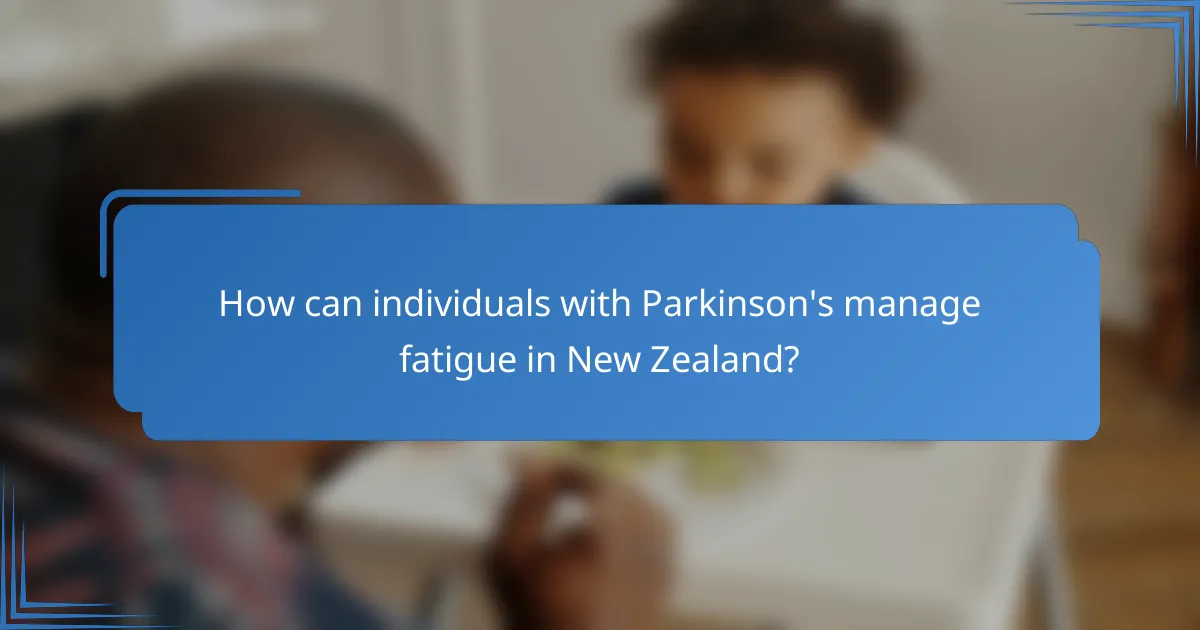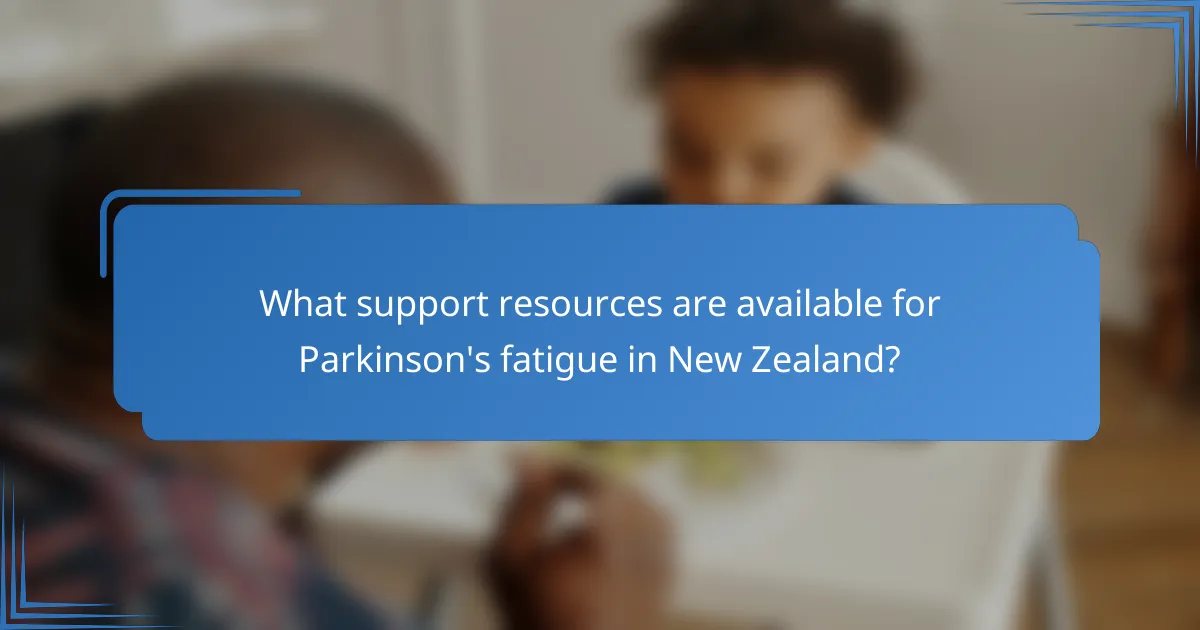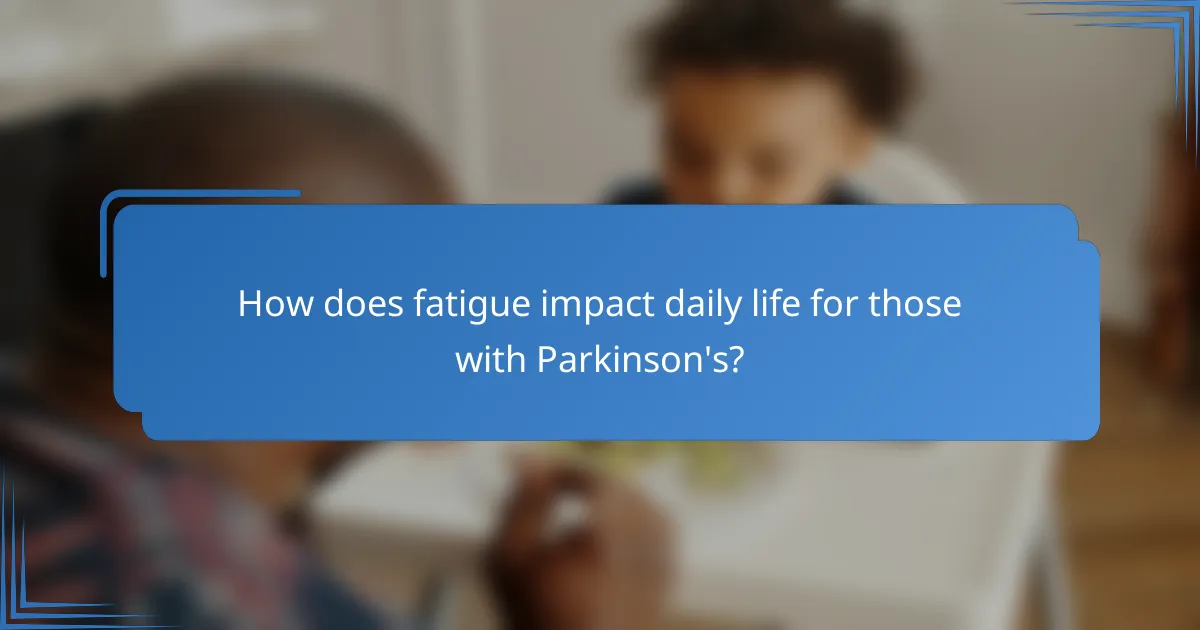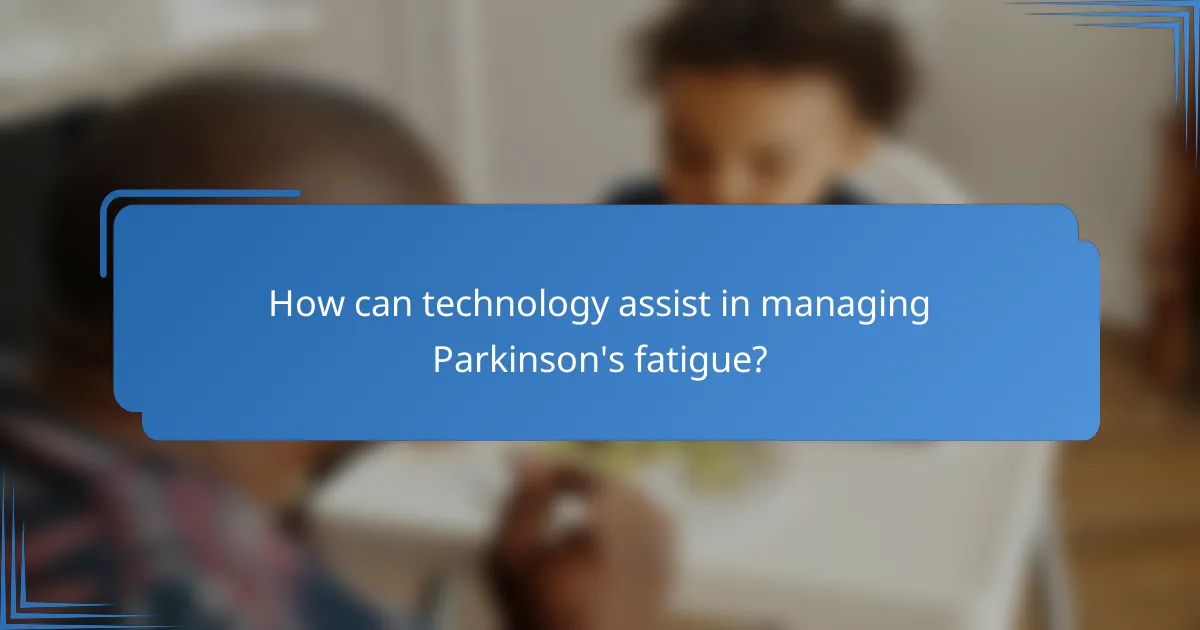Managing fatigue is a crucial aspect for individuals living with Parkinson’s disease, particularly in New Zealand. By incorporating energy conservation techniques, structured daily routines, and proper nutrition, individuals can enhance their energy levels and overall quality of life. Additionally, a variety of local support resources, including support groups and healthcare professionals, are available to provide guidance and assistance in navigating these challenges.

How can individuals with Parkinson’s manage fatigue in New Zealand?
Individuals with Parkinson’s in New Zealand can manage fatigue through a combination of energy conservation techniques, scheduled rest periods, adaptive daily routines, proper nutrition, and physical activity. These strategies help optimize energy levels and improve overall quality of life.
Energy conservation techniques
Energy conservation techniques involve adjusting daily activities to reduce fatigue. This can include prioritizing tasks, breaking them into smaller steps, and using assistive devices to minimize physical strain. For example, using a wheeled cart for grocery shopping can save energy compared to carrying bags.
Consider implementing the “two-hour rule,” where individuals alternate between activity and rest every two hours to maintain energy levels throughout the day. This approach helps prevent burnout and allows for more manageable daily routines.
Scheduled rest periods
Incorporating scheduled rest periods into the day is crucial for managing fatigue. Short breaks of 10-15 minutes every hour can help recharge energy levels. It’s beneficial to find a quiet, comfortable space for these breaks to maximize their effectiveness.
Creating a daily schedule that includes designated rest times can help individuals with Parkinson’s stay organized and ensure they do not overexert themselves. Using reminders or alarms can assist in adhering to this schedule.
Adaptive daily routines
Adaptive daily routines involve modifying how tasks are approached to accommodate energy levels. This may include shifting more demanding activities to times of the day when energy is typically higher, such as mornings for many people.
Utilizing a planner to outline daily tasks and incorporating flexibility can help manage unexpected fatigue. For instance, if a planned activity becomes too tiring, it can be postponed or adjusted without guilt.
Nutrition and hydration strategies
Proper nutrition and hydration are essential for managing fatigue. A balanced diet rich in fruits, vegetables, whole grains, and lean proteins can provide sustained energy. Staying hydrated is equally important; individuals should aim for at least 1.5 to 2 liters of water daily, adjusting based on activity levels.
Planning meals and snacks can prevent energy dips. Small, frequent meals throughout the day can help maintain stable blood sugar levels, which is vital for energy management.
Physical activity recommendations
Engaging in regular physical activity can help combat fatigue associated with Parkinson’s. Low-impact exercises, such as walking, swimming, or yoga, are often recommended, as they can improve strength and endurance without excessive strain.
It’s advisable to aim for at least 150 minutes of moderate exercise per week, spread out over several days. Consulting with a healthcare provider or physiotherapist can help tailor an exercise program that suits individual capabilities and energy levels.

What daily routines help manage Parkinson’s fatigue?
Daily routines that focus on energy management can significantly alleviate fatigue associated with Parkinson’s disease. Establishing a structured schedule that includes specific activities can help individuals maintain energy levels throughout the day.
Morning energy-boosting activities
Starting the day with energy-boosting activities can set a positive tone. Gentle exercises such as stretching or yoga can help improve circulation and flexibility, which may enhance overall energy. Aim for 15-30 minutes of light activity to kickstart your day.
Incorporating a nutritious breakfast rich in protein and complex carbohydrates can provide sustained energy. Foods like oatmeal, eggs, or yogurt with fruits are excellent choices to fuel your morning.
Midday rest and relaxation practices
Taking time for rest and relaxation during the midday can help recharge energy levels. Short naps of about 20-30 minutes can be beneficial, allowing the body to recover without disrupting nighttime sleep.
Engaging in mindfulness practices, such as meditation or deep breathing exercises, can also help reduce stress and improve focus. Setting aside 10-15 minutes for these activities can make a noticeable difference in energy and mood.
Evening wind-down routines
Establishing a calming evening routine is essential for preparing the body for restful sleep. Activities such as reading, gentle stretching, or listening to soothing music can help signal to the body that it’s time to relax.
Avoiding screens and bright lights at least an hour before bedtime can improve sleep quality. Aim for a consistent bedtime to help regulate your sleep cycle, which is crucial for managing fatigue effectively.

What support resources are available for Parkinson’s fatigue in New Zealand?
In New Zealand, individuals experiencing Parkinson’s-related fatigue can access various support resources tailored to their needs. These include local support groups, online communities, and healthcare professional resources that provide valuable information and assistance.
Local support groups
Local support groups in New Zealand offer a space for individuals with Parkinson’s to share experiences and coping strategies related to fatigue. These groups often meet regularly and provide emotional support, practical advice, and social interaction, which can help alleviate feelings of isolation.
To find a support group near you, consider contacting organizations like Parkinson’s New Zealand, which maintains a directory of local chapters and their meeting schedules. Participating in these groups can enhance your understanding of managing fatigue effectively.
Online forums and communities
Online forums and communities provide a platform for individuals with Parkinson’s to connect and discuss fatigue management strategies. Websites such as the Parkinson’s New Zealand website and social media groups allow for sharing tips, resources, and personal stories, making it easier to find support from others facing similar challenges.
Engaging in these online spaces can be particularly beneficial for those who may have difficulty attending in-person meetings due to fatigue. Look for forums that focus specifically on fatigue management to gain targeted insights and advice.
Healthcare professional resources
Healthcare professionals in New Zealand play a crucial role in addressing Parkinson’s fatigue. Neurologists, occupational therapists, and physiotherapists can provide tailored strategies and interventions to help manage energy levels effectively. They may suggest lifestyle changes, exercise programs, or medication adjustments based on individual needs.
It’s essential to have open discussions with your healthcare team about fatigue. Regular check-ups can help monitor symptoms and adapt treatment plans as necessary, ensuring a comprehensive approach to managing fatigue associated with Parkinson’s disease.

How does fatigue impact daily life for those with Parkinson’s?
Fatigue significantly affects daily life for individuals with Parkinson’s, leading to decreased energy levels and increased difficulty in performing everyday tasks. This can result in challenges with mobility, independence, and overall quality of life.
Effects on mobility and independence
Fatigue can severely limit mobility for those with Parkinson’s, making it harder to walk, stand, or perform physical activities. Many individuals may experience slower movement, increased risk of falls, and a greater reliance on assistive devices.
As fatigue sets in, the ability to carry out daily routines, such as grocery shopping or attending social events, diminishes. This can lead to a cycle of reduced independence, where individuals may avoid activities that require significant energy, further limiting their mobility.
Influence on mental health
The impact of fatigue on mental health can be profound for those with Parkinson’s. Feelings of frustration, sadness, or anxiety may arise due to the inability to engage in previously enjoyed activities or maintain social connections.
Moreover, chronic fatigue can contribute to cognitive decline, making it harder to concentrate or make decisions. It’s crucial for individuals to seek support from mental health professionals or support groups to address these emotional challenges and develop coping strategies.

What are the best practices for caregivers of individuals with Parkinson’s fatigue?
Caregivers can help manage Parkinson’s fatigue by implementing structured routines, encouraging rest, and fostering supportive environments. These practices enhance the quality of life for both caregivers and individuals experiencing fatigue.
Understanding fatigue management
Fatigue management involves recognizing the signs of fatigue and adjusting daily activities accordingly. Caregivers should monitor energy levels and encourage short breaks during tasks to prevent overwhelming fatigue.
Establishing a balanced routine that includes periods of activity and rest can significantly improve energy levels. For instance, engaging in light physical activities like stretching or walking for 10-15 minutes can help rejuvenate energy without causing excessive strain.
Creating supportive environments
Creating a supportive environment is crucial for individuals with Parkinson’s fatigue. This includes organizing living spaces to minimize physical strain and ensuring easy access to necessary items. For example, placing frequently used items within reach can reduce the need for unnecessary movements.
Additionally, fostering a calm atmosphere can alleviate stress, which often exacerbates fatigue. Consider incorporating soft lighting, comfortable seating, and quiet spaces for relaxation. Regularly checking in with the individual to assess their needs and preferences can further enhance their comfort and well-being.

How can technology assist in managing Parkinson’s fatigue?
Technology can significantly aid in managing fatigue associated with Parkinson’s by providing tools for energy tracking, reminders for medication, and facilitating communication with healthcare providers. These resources help individuals optimize their daily routines and maintain a better quality of life.
Energy management apps
Energy management apps are designed to help individuals with Parkinson’s monitor their energy levels throughout the day. These applications can track activities, rest periods, and fatigue patterns, allowing users to identify when they are most energetic and when they need to conserve energy.
Examples of popular energy management apps include MyTherapy and Fatigue Tracker. Users can set reminders for breaks and adjust their daily schedules based on their energy levels, ultimately improving their productivity and well-being.
Wearable devices
Wearable devices, such as fitness trackers and smartwatches, can play a crucial role in managing fatigue. These devices can monitor physical activity, sleep quality, and heart rate, providing valuable insights into how lifestyle factors affect energy levels.
For instance, a wearable device may alert users when they have been inactive for too long or suggest optimal sleep times based on their activity patterns. This data can help individuals make informed decisions about their daily routines.
Telehealth services
Telehealth services offer convenient access to healthcare professionals, which can be particularly beneficial for those managing Parkinson’s fatigue. Virtual appointments allow patients to discuss their symptoms, medication adjustments, and fatigue management strategies without the need for travel.
Many telehealth platforms also provide educational resources and support groups, fostering a sense of community and shared experiences. This can alleviate feelings of isolation and empower individuals to take control of their health.
Smart home technology
Smart home technology can enhance daily living for individuals with Parkinson’s by automating tasks and reducing physical strain. Devices such as smart lights, thermostats, and voice-activated assistants can help streamline routines and conserve energy.
For example, a smart assistant can remind users to take breaks or manage household tasks like adjusting lighting or temperature, allowing individuals to focus their energy on activities that matter most to them.
